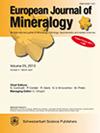reerite, KFe6(PO4)4(OH)7(H2O)6⋅4H2O,来自德国巴伐利亚州Pleystein地区Kreuzberg伟晶岩的首个新矿物
IF 1.7
3区 地球科学
Q2 MINERALOGY
引用次数: 0
摘要
摘要regeite (KFe6(PO4)4(OH)7(H2O)6⋅4H2O)是在巴伐利亚州Oberpfalz Pleystein的Kreuzberg伟晶岩中首次发现的新矿物。它是在一个沙质石英标本的孔洞中发现的,与岩桥石、强石和磷菱铁矿有关。白长石以黄绿色棱镜的形式出现,通常宽5至20微米,长0.1毫米。晶体在{100}上呈扁平状,在[001]上呈细长状,它们的形状为{100}、{010}和{011}。测量密度为2.69(2)g cm−3。光学上,雷长石晶体是双轴的(+),α=1.670(5), β=1.690(5), γ=1.730(5)(以白光测量),2V(平均值)是76(2)度。电子探针分析和晶体结构细化的经验公式为K0.95(Fe5.663+Ti0.45)Σ6.11(PO4)3.95(OH)7[(H2O)5.33(OH)0.88]Σ6.21⋅4H2O。钙长石具有单斜对称性,空间群P21/c和单元参数a=15.408(11) Å, b=17.311(11) Å, c=9.870(11) Å, β=95.42(2)°,V=2621(3) Å3, Z=4。利用同步加速器单晶数据对晶体结构进行了细化,在I>3σ(I)的6088次反射下,wRobs=0.065。结构类型以前没有报道过。它由平行于{100}的异多面体层组成,由铁中心八面体和PO4四面体组成。这些层通过边缘共享的八面体二聚体相互连接,沿着[001]形成被K+离子和水分子占据的裂隙状通道。本文章由计算机程序翻译,如有差异,请以英文原文为准。
Regerite, KFe6(PO4)4(OH)7(H2O)6 ⋅ 4H2O, the first new mineral species from the Kreuzberg pegmatite, Pleystein, Oberpfalz, Bavaria, Germany
Abstract. Regerite, KFe6(PO4)4(OH)7(H2O)6 ⋅ 4H2O, is the first new mineral species to be characterised from the Kreuzberg pegmatite, Pleystein, in the Oberpfalz, Bavaria. It was found in vugs on a specimen of drusy quartz, associated with rockbridgeite, strengite and phosphosiderite. Regerite occurs as clusters of yellowish-green prisms, typically 5 to 20 µm wide and up to 0.1 mm long. The crystals are flattened on {100} and elongated along [001], and they display the forms {100}, {010} and {011}. The measured density is 2.69(2) g cm−3. Optically, regerite crystals are biaxial (+), with α=1.670(5), β=1.690(5) and γ=1.730(5) (measured in white light), and 2V (meas) is 76(2)∘. The empirical formula from electron microprobe analyses and crystal structure refinement is K0.95(Fe5.663+Ti0.45)Σ6.11(PO4)3.95(OH)7[(H2O)5.33(OH)0.88]Σ6.21 ⋅ 4H2O. Regerite has monoclinic symmetry, with space group P21/c and unit-cell parameters a=15.408(11) Å, b=17.311(11) Å, c=9.870(11) Å, β=95.42(2)∘, V=2621(3) Å3 and Z=4. The crystal structure was refined using synchrotron single-crystal data to wRobs=0.065 for 6088 reflections with I>3σ(I). The structure type has not been previously reported. It is made of heteropolyhedral layers parallel to {100} that consist of Fe-centred octahedra and PO4 tetrahedra. The layers are interconnected via edge-shared octahedral dimers to form slit-like channels along [001] that are occupied by K+ ions and water molecules.
求助全文
通过发布文献求助,成功后即可免费获取论文全文。
去求助
来源期刊
CiteScore
2.80
自引率
9.50%
发文量
40
审稿时长
6-12 weeks
期刊介绍:
EJM was founded to reach a large audience on an international scale and also for achieving closer cooperation of European countries in the publication of scientific results. The founding societies have set themselves the task of publishing a journal of the highest standard open to all scientists performing mineralogical research in the widest sense of the term, all over the world. Contributions will therefore be published primarily in English.
EJM publishes original papers, review articles and letters dealing with the mineralogical sciences s.l., primarily mineralogy, petrology, geochemistry, crystallography and ore deposits, but also biomineralogy, environmental, applied and technical mineralogy. Nevertheless, papers in any related field, including cultural heritage, will be considered.

 求助内容:
求助内容: 应助结果提醒方式:
应助结果提醒方式:


